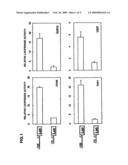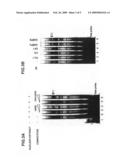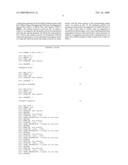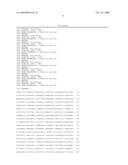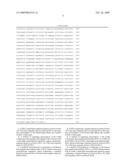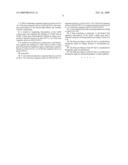Patent application title: Transcriptional Regulation of High Affitnity Ige Receptor Gamma-Chain
Inventors:
Chisei Ra (Tokyo, JP)
Kyoko Takahashi (Tokyo, JP)
IPC8 Class: AA61K3817FI
USPC Class:
514 12
Class name: Designated organic active ingredient containing (doai) peptide containing (e.g., protein, peptones, fibrinogen, etc.) doai 25 or more peptide repeating units in known peptide chain structure
Publication date: 2009-02-26
Patent application number: 20090054324
Claims:
1. A DNA comprising a sequence based on at least nt-98 to -96 of the base
sequence shown in SEQ ID NO:1, that regulates transcription of the human
high affinity IgE receptor (FcεRI) γ-chain gene.
2. A method of regulating transcription of the FcεRI γ-chain gene, that regulates the binding of Sp1 with an FcεRI γ-chain gene transcriptional regulatory region comprising a sequence based on at least nt-98 to -96 of the base sequence shown in SEQ ID NO:1.
3. A method of screening for a compound, or salt thereof, that regulates the binding of Sp1 with an FcεRI γ-chain gene transcriptional regulatory region comprising a sequence based on at least nt-98 to -96 of the base sequence shown in SEQ ID NO:1.
4. A DNA comprising a sequence based on at least nt-84 to -82 of the base sequence shown in SEQ ID NO:2, that regulates transcription of the human high affinity IgE receptor (FcεRI) γ-chain gene.
5. A method of regulating transcription of the FcεRI γ-chain gene, that regulates the binding of Elf-1 or GABP α/β heterodimer with an FcεRI γ-chain gene transcriptional regulatory region comprising a sequence based on at least nt-84 to -82 of the base sequence shown in SEQ ID NO:2.
6. A method of screening for a compound, or salt thereof, that regulates the binding of Elf-1 or GABP α/β heterodimer with an FcεRI γ-chain gene transcriptional regulatory region comprising a sequence based on at least nt-84 to -82 of the base sequence shown in SEQ ID NO:2.
7. A DNA comprising a sequence based on at least nt-65 to -61 of the base sequence shown in SEQ ID NO:3, that regulates transcription of the human high affinity IgE receptor (FcεRI) γ-chain gene.
8. A method of regulating transcription of the FcεRI γ-chain gene, that regulates the binding of C/EBP with an FcεRI γ-chain gene transcriptional regulatory region comprising a sequence based on at least nt-65 to -61 of the base sequence shown in SEQ ID NO:3.
9. A method of screening for a compound, or salt thereof, that regulates the binding of C/EBP with an FcεRI γ-chain gene transcriptional regulatory region comprising a sequence based on at least nt-65 to -61 of the base sequence shown in SEQ ID NO:3.
10. (canceled)
11. A vector that incorporates a sequence based on at least nt-98 to -96 of the base sequence shown in SEQ ID NO:1, a sequence based on at least nt-8 to -82 of the base sequence shown in SEQ ID NO:2, or a sequence based on at least nt-65 to -61 of the base sequence shown in SEQ ID NO:3.
12. A screening kit used in the screening method according to claim 3, 6, or 9.
13. A drug containing a compound, or salt thereof, that regulates transcription of the FcεRI γ-chain gene and is obtained using the screening method according to claim 3, 6, or 9.
14. The drug according to claim 13, that is a prophylactic/therapeutic agent for allergic diseases or autoimmune diseases.
15. The drug according to claim 13, that is a prophylactic/therapeutic agent for thrombosis.
16. The drug according to claim 13, that is a prophylactic/therapeutic agent for glomerulonephritis or lupus nephritis.
Description:
FIELD OF THE INVENTION
[0001]The present invention relates to the regulation of the expression of the high affinity IgE receptor γ-chain and more particularly relates to transcriptional control of the high affinity IgE receptor γ-chain gene and to the utilization of this transcriptional control.
BACKGROUND
[0002]The high affinity IgE receptor (referred to below as FcεRI) expressed on the cell membrane of mast cells and basophils is known to be a key glycoprotein in the type I allergic reaction. When antigen-specific IgE's bonded to FcεRI are crosslinked by the corresponding polyvalent antigen (for example, cedar pollen antigen for individuals suffering from cedar pollen allergy, dust mite antigen for individuals suffering from dust mite allergies), the FcεRI's are clustered, the signal transduction mechanism operates, and the mast cells undergo initial activation. As a result, various chemical transmitters that evoke allergic inflammation, i.e., most prominently the histamine preliminarily stored in cell granules, are released and the new synthesis and release of leukotriene, prostaglandin, and so forth, which are intracellular metabolites, is explosively induced, evoking a type I allergic reaction.
[0003]In addition, cytokine secretion from mast cells is promoted by the clustering of FcεRI's on the mast cells, inducing the expression of various adhesion molecules in the neighboring vascular endothelial cells. Eosinophils and lymphocytes in the blood aggregate by binding via these adhesion molecules to the vascular endothelial cells at the site of inflammation. The late allergic reaction is evoked as a result. Moreover, the FcεRI expressed by the Langerhans cells of the skin is presumed to contribute to the pathogenesis of atopic dermatitis by antigen presentation and cytokine production.
[0004]Based on the preceding, a promising strategy for the development of agents for allergy prophylaxis treatment is to target the FcεRI that specifically mediates type I allergy and thereby block signal transduction from this receptor at the point of origin.
[0005]FcεRI is also known to participate in platelet activation and glomerulonephritis, and given this it is also promising to carry out the development of thrombosis and glomerulonephiritis by targeting FcεRI.
[0006]In humans, human FcεRI functions expressed on the cell surface as a tetramer of an α-chain, a β-chain, and 2 γ-chains or as a trimer of an α-chain and 2 γ-chains. The extracellular region of the α-chain binds-directly to IgE while the β-chain γ-chain participate in signal transduction into the cell. The γ-chain assembles with the other molecules, which have a ligand binding site, to form a receptor on the cell surface. When ligand binds to the receptor's ligand binding site, the γ-chain transduces the signal into the cell.
[0007]For example, the γ-chain has been reported to perform the function of transmitting an activation signal into the cell in the FcεRI-mediated induction of allergic reactions (refer, for example, to Non-Patent documents 1 to 3). In addition, the γ-chain has been reported to induce the platelet activation reaction by associating with the collagen receptor GP VI on the platelet (refer, for example, to Non-Patent document 4).
[0008]The γ-chain is also a constituent element of the IgG receptors FcγRIII and FcγRI and the IgA receptor FcαR, and the suggestion has also been made these FcR's participate in glomerulonephritis-(refer, for example, to Non-Patent document 5).
Non-Patent document 1 Ra C et al., Nature, 341:752-754 (1989);Non-Patent document 2 Blank U et al., Nature, 337; 187-189 (1989);Non-Patent document 3 Kinet J P, Annual Review of Immunology, 17:931-972 (1999);Non-Patent document 4 Konishi H et al., Circulation, 105(8):912-916 (2002);Non-Patent document 5 Suzuki Y et al., Kidney Int., 54(4):1166-1174 (1998)
[0009]However, on the subject of transcriptional regulatory regions for the high affinity human IgE receptor γ-chain, only the analysis by Brini A T et al., in 1993 has been carried out, and to date no detailed analysis that precisely identifies transcriptional regulatory elements and/or transcriptional regulatory factors has been performed.
[0010]As a result of intensive investigations, the present inventors succeeded in identifying, from within previously unanalyzed regions, regions that participate in the transcriptional regulation of the human FcεRI γ-chain gene and in identifying transcription factors that bind to these regions and were thereby able to achieve the present invention.
SUMMARY
[0011]That is, the present invention provides (1) a DNA comprising the full length or a portion of the base sequence shown in SEQ ID NO:1, that regulates transcription of the human high affinity IgE receptor (FCεRI) γ-chain gene; (2) a method of regulating transcription of the FcεRI γ-chain gene, that regulates the binding of Sp1 with an FcεRI γ-chain gene transcriptional regulatory region comprising the full length or a portion of the base sequence shown in SEQ ID NO:1; (3) a method of screening for a compound, or salt thereof, that regulates the binding of Sp1 with an FcεRI γ-chain gene transcriptional regulatory region comprising the full length or a portion of the base sequence shown in SEQ ID NO:1; (4) a DNA comprising the full length or a portion of the base sequence shown in SEQ ID NO:2, that regulates transcription of the human high affinity IgE receptor (FcεRI) γ-chain gene; (5) a method of regulating transcription of the FcεRI γ-chain gene, that regulates the binding of Elf-1 or GABP α/β heterodimer with an FcεRI γ-chain gene transcriptional regulatory region comprising the full length or a portion of the base sequence shown in SEQ ID NO:2; (6) a method of screening for a compound, or salt thereof, that regulates the binding of Elf-1 or GABP α/β heterodimer with an FcεRI γ-chain gene transcriptional regulatory region comprising the full length or a portion of the base sequence shown in SEQ ID NO:2; (7) a DNA comprising the full length or a portion of the base sequence shown in SEQ ID NO:3, that regulates transcription of the human high affinity IgE receptor (FcεRI) γ-chain gene; (8) a method of regulating transcription of the FcεRI γ-chain gene, that regulates the binding of C/EBP with an FcεRI γ-chain gene transcriptional regulatory region comprising the full length or a portion of the base sequence shown in SEQ ID NO:3; (9) a method of screening for a compound, or salt thereof, that regulates the binding of C/EBP with an FcεRI γ-chain gene transcriptional regulatory region comprising the full length or a portion of the base sequence shown in SEQ ID NO:3. (10) a method of regulating transcription of the human high affinity IgE receptor (FcεRI) γ-chain gene by controlling functional regulation by at least one transcription factor selected from Sp1, Elf-1, GABP α/β heterodimer, and C/EBP or by controlling the interaction between or among transcription factors; (11) a vector that incorporates the full length or a portion of the base sequence shown in SEQ ID NO:1, SEQ ID NO:2, or SEQ ID NO:3; (12) a screening kit used in the screening method according to the preceding (3), (6), or (9); (13) a drug containing a compound, or salt thereof, that regulates transcription of the FcεRI γ-chain gene and is obtained using the screening method according to the preceding (3), (6), or (9) or the transcriptional regulatory method according to the preceding (10); (14) the drug described in the preceding (13), that is a prophylactic/therapeutic agent for allergic diseases or autoimmune diseases; (15) the drug described in the preceding (13), that is a prophylactic/therapeutic agent for thrombosis; and (16) the drug described in the preceding (13), that is a prophylactic/therapeutic agent for glomerulonephritis or lupus nephritis.
[0012]Thus, the present inventors cloned the human γ-chain gene and using a human cell line carried out a reporter assay on the region upstream from the translation initiation point. The presence of two enhancer elements in the nt-103/-75 region (here and in the following, the translation initiation point is designated as base number +1) was elucidated as a result, i.e., the region shown by SEQ ID NO:1, containing nt-98 to -96, and the region shown by SEQ ID NO:2, containing nt-84 to -82. With regard to these elements, it was found by EMSA that Sp1 binds to the former and that Elf-1 or GABP α/β heterodimer binds to the latter.
[0013]In addition, the region of SEQ ID NO:3, which contains nt-65 to -61 and exhibits homology with the C/EBP binding sequence, was found to contribute to activation of the γ-chain promoter. On the occasion of carrying out reporter assays while inducing overexpression of various combinations of these transcription factors, it was shown that transcription activation was synergistically increased and that the use of a plurality of the transcription factors resulted in cooperative activation of the γ-chain promoter.
[0014]Moreover, in view of the following facts as cited in the preceding: the γ-chain functions to transmit the activation signal into the cell during induction of the FcεRI-mediated allergic reaction, the γ-chain induces the platelet activation reaction by associating with the collagen receptor GP VI on the platelet, and the γ-chain is a constituent element of the IgG receptors FcγRIII and FcγRI and the IgA receptor FcαR and these FcR's participate in the pathogenesis of glomerulonephritis, the expression regulatory regions and control factors identified by the present inventors for the γ-chain gene are useful as targets for the development of prophylactic/therapeutic agents for, inter alia, allergic diseases, autoimmune diseases, thrombosis, glomerulonephritis, and lupus nephritis. The present invention is also useful for genetic analysis in personalized medicine.
[0015]The genomic structure and base sequence of the human FcεRI γ-chain gene have already been elucidated (GenBank, accession number M33196, SEQ ID NO:4). The phrase, "comprising the full length or a portion of the base sequence shown in SEQ ID NO:1", used in the present invention means comprising the main portion essential for transcriptional regulation of the FcεRI γ-chain gene and in particular comprising a sequence based on nt-98 to -96 (the translation initiation point is designated as base number +1).
[0016]The phrase, "comprising the full length or a portion of the base sequence shown in SEQ ID NO:2", used in the present invention means comprising the main portion essential for transcriptional regulation of the FcεRI γ-chain gene and in particular comprising a sequence based on nt-84 to -82 (the translation initiation point is designated as base number +1).
[0017]The phrase, "comprising the full length or a portion of the base sequence shown in SEQ ID NO:3", used in the present invention means comprising the main portion essential for transcriptional regulation of the FcεRI γ-chain gene and in particular comprising a sequence based on nt-65 to -61 (the translation initiation point is designated as base number +1).
[0018]The "high affinity IgE receptor γ-chain" referenced in the present invention was discovered as a high affinity IgE receptor γ-chain, but subsequent findings have shown that, inter alia, other immunoglobulin Fc receptors also contain it in common as a constituent element, and at the present time it is also known as "immunoglobulin receptor γ-chain".
[0019]The present invention provides base sequences that participate in transcriptional regulation of the human FcεRI γ-chain gene and establishes a method of screening for compounds and salts thereof that inhibit γ-chain expression and also establishes a kit for use in this screening method.
DESCRIPTION OF THE DRAWINGS
[0020]FIG. 1 shows the transcriptional regulatory activity according to a reporter assay of the 5' region of the human FcεRI γ-chain gene;
[0021]FIG. 2 shows the identification of binding factors by a gel shift assay, wherein (A) is a competitive test using unlabeled double-stranded oligoDNA (the added unlabeled double-stranded DNA was as follows: lanes 3, 4; sequence identical to probe, lanes 5, 6; three bases substituted in the probe sequence) and (B) is a test using antibody;
[0022]FIG. 3 shows the identification of binding factors by a gel shift assay, wherein (A) is a competitive test using unlabeled double-stranded oligoDNA (the added unlabeled double-stranded DNA was as follows: lanes 3, 4: sequence identical to probe, lanes 5, 6: three bases substituted in the probe sequence) and (B) is a test using antibody;
[0023]FIG. 4 shows the effect of site-directed mutagenesis on human FcεRI γ-chain gene promoter activity; and
[0024]FIG. 5 shows the effect of the overexpression of the different transcription factors on human FcεRI γ-chain gene promoter activity in HeLa cells.
DETAILED DESCRIPTION
[0025]Embodiments of the present invention will now be described. The following embodiments are examples for the purpose of explaining the present invention, but the present invention should not be construed as limited only to these embodiments. The present invention can be implemented using various modalities while preserving the essential features of the present invention.
[0026]The present invention, based on the determination of DNA regions that participate in regulating transcription of the FcεRI γ-chain gene and the identification of transcriptional regulatory factors that bind to these regions, enables the construction of a method of screening for compounds and salts thereof that inhibit expression of the FcεRI γ-chain and of a kit for use in this screening. The present invention thereby contributes to the development of agents for the prophylaxis or treatment of allergic diseases, autoimmune diseases, thrombosis, glomerulonephritis, and lupus nephritis. For example, the development of compounds or salts thereof that inhibit γ-chain expression is possible based on the strategy of searching for substances that inhibit the binding of the identified transcriptional regulatory factor Sp1 with the specified gene region.
[0027]The aforementioned salt of a compound denotes, inter alia, a salt with a physiologically acceptable acid (for example, an inorganic acid or an organic acid) or a salt with a physiologically acceptable base (for example, an alkali metal). Physiologically acceptable acid-adduct salts are particularly preferred. Specific examples are salts with hydrochloric acid, phosphoric acid, hydrobromic acid, and sulfuric acid within the realm of inorganic acids and salts with acetic acid, formic acid, propionic acid, fumaric acid, maleic acid, succinic acid, tartaric acid, citric acid, malic acid, oxalic acid, benzoic acid, methanesulfonic acid, benzenesulfonic acid, and so forth within the realm of organic acids.
[0028]An FcεRI γ-chain gene transcription-regulating compound or salt thereof that is obtained using the screening method and screening kit according to the present invention is useful as an agent for the prophylaxis/treatment of allergic diseases, autoimmune diseases, thrombosis, glomerulonephritis, and lupus nephritis.
[0029]A compound or salt thereof obtained by means of the present invention can be used via the oral route as, for example, a tablet or pill, possibly sugar coated, a capsule, or a microcapsule, or can be used via a parenteral route in the form of an injectable, for example, a sterile solution or suspension with water or with a pharmaceutically acceptable liquid other than water. For example, production can be carried out by mixing a compound or salt thereof obtained by means of the present invention, in the unit dose form required for the elaboration of a generally recognized formulation, with, for example, a physiologically acceptable carrier, flavorant, filler, vehicle, preservative, stabilizer, binder, and so forth.
[0030]The amount of effective component in these formulations is an amount that provides an appropriate dose in the indicated range. Additives that can be incorporated into, for example, a tablet or capsule, can be exemplified by binders such as gelatin, corn starch, tragacanth, gum arabic, and so forth; fillers such as crystalline cellulose; swelling agents such as corn starch, gelatin, alginic acid, and so forth; lubricants such as magnesium stearate and so forth; sweeteners such as sucrose, lactose, saccharin and so forth; and flavorants such as peppermint, Japanese wintergreen (Gaultheria adenothrix) oil, and cherry. When the unit formulation takes the form of a capsule, starting material of the aforementioned type may also include a liquid carrier such as an oil or fat. Sterile compositions for injection can be formulated by the usual methods for producing a formulation, such as dissolving or suspending a natural vegetable oil or the like, such as sesame oil or coconut oil, and the active ingredient in a vehicle such as injection-grade water.
[0031]Examples of aqueous solutions for use as injection-grade water include physiological saline, isotonic solutions containing glucose and/or other adjuvants (such as D-sorbitol, D-mannitol, sodium chloride, and so forth), and suitable dissolution auxiliaries such as alcohols (e.g., ethanol), polyalcohols (e.g., propylene glycol, polyethylene glycol, and so forth), and nonionic surfactants (e.g., Polysorbate 80®, HCO-50, and so forth) can be used in combination therewith. Sesame oil and soy oil are examples of dissolution auxiliaries, and, for example, benzyl benzoate, benzyl alcohol, and so forth can be used in combination therewith as dissolution auxiliaries. Buffers (e.g., phosphate buffers, sodium acetate buffers, and so forth), analgesics (e.g., benzalkonium chloride, procaine chloride, and so forth), stabilizers (e.g., human serum albumin, polyethylene glycol, and so forth), preservatives (e.g., benzyl alcohol, phenol, and so forth), antioxidants, and the like may also be incorporated. The formulated injectable is usually filled into a suitable ampule.
[0032]A formulation obtained as described in the preceding is safe and exhibits low toxicity and can therefore be administered to, for example, mammals and warm-blooded animals (for example, human, rat, mouse, guinea pig, rabbit). The administered dose of a compound or salt obtained by means of the present invention will vary as a function of, inter alia, the targeted disease, the recipient of the administration, and the route of administration. As an example, when a compound or salt thereof obtained by means of the present invention is administered orally for the purpose of treating hay fever, 0.1 mg to 1.0 g and preferably about 1.0 mg to 50 mg of the compound or salt thereof is generally administered per day to an adult (60 kg).
EXAMPLES
[0033]The present invention is described in additional detail in the following using examples, but the present invention is not limited to these examples. The individual skilled in the art will be able to implement not only the examples given in the following, but will also be able to add various modifications; these modifications are also encompassed in the claims provided herein.
Example 1
Measurement of the Transcriptional Regulatory Activity of the 5' region of the human FcεRI γ-Chain Gene
[0034]nt-103 to -1 and nt-74 to -1 at the 5' region of the human FcεRI γ-chain gene were each incorporated upstream from the luciferase gene in the pGL3Basic Vector (Promega), a plasmid that contains the firefly luciferase gene as a reporter gene, to construct the respective reporter plasmids. 5 μg of the particular reporter plasmid and 0.1 μg pRL-CMV Vector (Promega), a plasmid encoding the Renilla luciferase gene under CMV promoter control, as the control were transfected into each of four γ-chain-expressing human cell lines (Jurkat, KU812, THP1, U937) by electroporation (300 V, 950 μF).
[0035]After cultivation for 20 to 24 hours at 37° C./5% CO2, the cells were recovered and cell lysis and measurement of the luciferase activity were carried out using a Dual Luciferase Assay Kit (Promega). At the time of measurement, the value of firefly luciferase activity/Renilla luciferase activity was calculated for each sample and the plasmid transfection efficiency and cell lysis efficiency were corrected.
[0036]The relative activity is shown in FIG. 1, where a value of 1 was assigned to the luciferase activity for transfection with a reporter plasmid containing only the firefly luciferase gene. As shown in FIG. 1, in all of the γ-chain-expressing cell lines used, the -103 to -1 region caused a major enhancement in luciferase activity, while the -74 to -1 region showed almost no enhancement effect of this nature. This example demonstrated that a transcription activating element with a common function in the four cell lines is present in the -103 to -75 region.
Example 2
Identification of Factors Binding to nt-102 to -88
[0037]Gel shift assays were carried out using a nuclear extract prepared from KU812 cells and the FITC-labeled double-stranded synthetic oligoDNA probe 5'-ATGGGGGAAGGCGTG-3' (corresponds to nt-102/-88 of the γ-chain gene).
[0038]Two unlabeled double-stranded synthetic oligoDNA's were used as the competitors: one having the same base sequence as the probe (comp) and one in which the three bases at nt-98 to -96 were changed (mut-comp).
[0039]30 μl of the aforementioned nuclear extract and 5 pmol of the aforementioned probe and 25 or 250 pmol of the competitor were mixed in a 10 mM HEPES buffer (pH 7.9) containing 400 ng poly(dl-dC), 1 mM MgCl2, 30 mM KCl, 1 mM DTT, and 5% glycerol and this was allowed to stand for 20 minutes at room temperature. This was followed by submission to 4% polyacrylamide gel electrophoresis using 0.5×TBE buffer (45 mM Tris, 45 mM boric acid, 1 mM EDTA). After phoresis for 2 to 3 hours at 120 V, the FITC fluorescence was detected using a FluorImager 595 (Amersham Bioscience). The results are shown in FIG. 2(A).
[0040]As shown in FIG. 2(A), several bands were observed (lane 2) that were shifted to positions of lower mobility than the band for the probe by itself. Among these, the band indicated by the arrow was extinguished in a competitor concentration-dependent manner when comp was added at 25 and 250 pmol (lanes 3 and 4), while extinction of this band did not occur in the case of the addition of mut-comp at 25 and 250 pmol (lanes 5 and 6). This showed that this band was a band in which nuclear protein was bound with specific recognition of the sequence based on nt-98 to -96.
[0041]The same results were obtained for the use of nuclear extracts prepared from Jurkat, THP1, and U937.
[0042]In order to identify this nuclear protein, 2 μg antibody (Santa Cruz Biotechnology, Inc.) against each of the transcription factors USF-1, USF-2, Sp1, and Ikaros was added. As shown in FIG. 2(B), the band indicated by the arrow was extinguished only for the addition of anti-Sp1 antibody. The same results were obtained for the use of nuclear extracts prepared from Jurkat, THP1, and U937. It was thus confirmed that the transcription factor Sp1 binds to the sequence based on nt-98 to -96.
Example 3
Identification of Factors Binding to nt-93 to -76
[0043]In order to identify factors binding to nt-93 to -76 of the human FcεRI γ-chain gene, a gel shift assay was carried out as in Example 2, but in this case using the double-stranded synthetic oligoDNA probe 5'GGCGTGGCAGGAAGAGGG-3' as the probe and using, as the competitors, two unlabeled double-stranded synthetic oligo's, one having the same base sequence as the probe (comp) and one in which the three bases at nt-84 to -82 were changed (mut-comp). The results are shown in FIG. 3(A).
[0044]As shown in FIG. 3(A), the two bands indicated by the arrows underwent a competitor concentration-dependent extinction in the case of the addition of 25 and 250 pmol comp (lanes 3 and 4), but were not extinguished in the case of the addition of 25 and 250 pmol mut-comp (lanes 5 and 6). This showed that these bands were bands in which nuclear protein was bound with specific recognition of the sequence based on nt-84 to -82. The same results were obtained for the use of nuclear extracts prepared from Jurkat, THP1, and U937.
[0045]In order to identify this nuclear protein, 2 μg antibody (Santa Cruz Biotechnology, Inc.) against each of the transcription factors PU.1, Fli1, Elf-1, GABP α, and GABP β was added. As shown in FIG. 3(B), of the two bands indicated by the arrows, the lower band was extinguished when anti-GABP α antibody and anti-GABP β antibody were added, while the upper band was extinguished by the addition of anti-Elf-1 antibody. The same results were obtained for the use of nuclear extracts prepared from Jurkat, THP1, and U937. It was thus confirmed that GABP α/β heterodimer and Elf-1 bound to the sequence based on nt-84 to -82.
Example 4
Influence of Base Substitution by Site-Directed Mutagenesis on γ-Chain Promoter Activity
[0046]The nt-177 to -1 fragment of the human FcεRI γ-chain gene was inserted upstream from the firefly luciferase gene in the pGL3Basic Vector (Promega), and the γ-chain gene fragment in the resulting plasmid was subjected to site-directed mutagenesis to construct four reporter plasmids. Thus, using a Quick Change Site-Directed Mutagenesis Kit (Stratagene), four reporter plasmids were obtained by replacing the following three or four bases, respectively: nt-98 to -96 (mut1), -84 to -82 (mut2), -77/-75/-74 (mut3), and -65/-64/-62/-61 (mut4). Proceeding as in Example 1, expression testing was carried out by transfecting the obtained reporter plasmids into human cell lines (Jurkat, KU812, THP1, U937). The relative activity is shown in FIG. 4, where a value of 1 was assigned to the luciferase activity for transfection with the reporter plasmid in which mutation had not been induced. As shown in FIG. 4, a decline in luciferase activity was observed for base substitution at nt-98 to -96, -84 to -82, and -65/-64/-62/-61, while the luciferase activity was unchanged for base substitution at -77/-75/-74.
[0047]The regions based on nt-98 to -96 and -84 to -82, which were shown in accordance with the preceding Examples 2 and 3 to bind, respectively, Sp-1 and GABP α/β or Elf-1, were confirmed in accordance with this example to function as transcription activation elements. In addition, the region based on nt-65 to -61, which is downstream from the preceding, was also shown to function as a transcription activation element. The region based on nt-65 to -61 is homologous with the binding motif of the C/EBP transcription factor. Moreover, when these results are considered in combination with the results of Example 1, the conclusion is drawn that this element has almost no transcription activating capacity by itself and functions cooperatively with the other two transcription activation elements.
Example 5
Influence of the Overexpression of Various Transcription Factors on γ-Chain Promoter Activity
[0048]Expression tests were carried out as in Example 1 by transfecting HeLa cells with 5 μg of a reporter plasmid prepared by inserting the nt-177 to -1 region of the human FcεRI γ-chain gene upstream from the firefly luciferase gene in the pGL3-Basic Vector (Promega) and with 3 μg of an expression plasmid for GABP α, GASP β, Elf-1, Sp1, and/or C/EBP α.
[0049]The relative activity is shown in FIG. 5, where a value of 1 is assigned to the luciferase activity for transfection with only the reporter plasmid. The black bar in the graph in FIG. 5 shows the relative activity for transfection with the expression plasmid(s) for the particular transcription factor(s), while the white bar shows the relative activity for transfection with the same amount of the corresponding empty vector. As shown in FIG. 5, the luciferase activity was increased several fold by the expression of GASP α/β only, or Elf-1 only, or Sp1 only, or C/EBP a only, in comparison to transfection with the empty vector, thus confirming that these transcription factors in fact activate the γ-chain promoter. In addition, a synergistic activation of the γ-chain promoter was shown for GABP α/β+Sp1+C/EBP α and for Elf-1+Sp1+C/EBP α.
Sequence CWU
1
4115DNAHomo sapiens 1atgggggaag gcgtg
15218DNAHomo sapiens 2ggcgtggcag gaagaggg
18318DNAHomo sapiens 3tctgtggtca
gggaactg 1845131DNAHomo
sapiensmisc_feature(614)..(614)n stands for any base 4atggattcac
ctgagatcag cagttcaaga ccagcctgat caacatggag aaaccccatc 60tctactaaaa
atacaaaatt agctgggcgt ggtggtgcat gcctgtaatg ccagctactc 120gggaggctga
gagaatcgct tgaacctggg aggcggaggt tgcggtgagc cgagatggcg 180ccattgcact
ccagcctggg caacaaagca agagtccgtc tcaaaaaaaa aaaaaaaaaa 240aaaaatctga
accaggtgga gtggaaaatg gcagatgtag acagcctttc ctgagcgtga 300gagtctcctc
attctgtggg ttaggagttg gtcattgaag ggctgacgct taagagccca 360gatctcccaa
ctcccttagt tggccttccg ggagccgccc ggtctcttgt gcaggaaggg 420gaaggggcca
aagcatgggg gaaggcgtgg caggaagagg gggactctgt ggtcagggaa 480ctgctcgctg
agcacagctg cacagtgctg tcagaacggc cgatctccag cccaagatga 540ttccagcagt
ggtcttgctc ttactccttt tggttgaaca agcaggtaag agggtttgtg 600agggatagcg
tgantggctc cagggtggaa gtccagagct tgggtctgag ggccaagtca 660aacacaggtg
aaggaaggct gacagtgggt aggtgggcat agggagaccc tgaggctagt 720cctctccagc
cccgacccag ggcactagac tcatagttcc ctcctttctt nttgccttct 780tacttcattc
cagacttttc tccgtattat tattattatt ttggagatgg agtcttgctc 840tgtcacccag
gctggagtgc agtggcgcaa tctctactca ctgcaacctc tgcctcctgg 900gttcaagcga
ttctcctgcc tcaggctccc gagtagctgg gactacaggt gcccgccacc 960acgcccggct
aagttaagta tttttggtag aaaccgggtt tcgtcatgtt gaccagggta 1020gtcttgaact
cctgactcaa gtgatccacc cacctcgacc tcccaaagtg ctgggattac 1080tggtgtgagc
cactgcaccc agctattatt attattaaaa aaagacaggg tcttactatg 1140ttggccacat
ccgtcttgaa ctcctggcct caagcaattc tcccacctcg gcctcccaaa 1200gtgctactgt
gcctggctga cttttctctt ttcagggttg atagaaagtg gcaggggaag 1260ggtctggttg
tatggcatga agagctggtc tggtgaaacg cctcatttct catgatgagc 1320atttcccatg
gggtgccttt ggtcttgtct gctgggagct gatctctagc tggtttaata 1380tacaaagcac
ccttggtnct ataattccag ctactcagaa ggctgaggca ggagaatcac 1440ttgaacccag
gaggtggagg ttgcagtgag ccaagatcgc accactgcac tctagcctgg 1500gggacagagt
gagactccgt ctcaaaaaaa aaaaaaagat tttacatata tatctctatc 1560tatctatcta
tatacacaca cacacacata cacacacaca cacacacaca cacacacaca 1620tatatatata
tatagagaga gagagagaga gagagagaga gagagatacc ctttaggaag 1680gtaggactct
gttcttgtgc ttgggagtaa ggcaaggata tagccaagac aaacagatgg 1740gattgctgtt
tctatgggtc attgttaatg ctccattctg tcagcagttg ataatgaggg 1800tgggcagcat
gagatcccca gttccagaga cctgagcgtc agctgagaaa tagaggcaga 1860aatgggaagg
tctctgaagc tctacagctc cagccactat ctaagaattc tcactcctcg 1920ttcactctgt
gttgtctgtg ctggattggt gtgtgtgtgt tggtggcagc tgggtgttgg 1980ggaggaggag
gtcagtaaac ttcagggaaa ctgtgaaatt gaaagagaat gactggggag 2040gaattccagc
agcctagctg agaaggtggg agcaagtatt aagttagcca ctggtctgct 2100gccgagggat
gaggagggag gaggcccgca gaggcacaaa ggaaagcatg ggctttagag 2160gcagaaaacc
tgcatttgag ttccagctct gtcacttaac tctgtggctc tgagtgagtt 2220acttagcttt
tccgagcctt ggtttcgtca cccataaaat ggcgatgatg atgtttccct 2280cacagggtag
ttttaagatt tgtgcaatat cgtgtgtgtg aaagagtgtt gcagaataaa 2340aagtacttga
ccgatgtcag caattgactg acgttagtca catgttccct actggtcctc 2400tgatacgggg
tgagagcagt ctctggagcc cagacttgat ttgatttttt aaattgcaca 2460aaacttcccc
tctcagagac ccagagagtg agtaataggg cagagtaaca ggagntggaa 2520tccatatagc
tgtggtcatt cccccagcct tgngttcagg gncaaaggta tctgtaaggt 2580ctggnnnnaa
cagacacact tttttttttt tttttttttt tttacatatt taagtgtctt 2640gtggtggnnn
agaaagcaac aaggctganc taggagatga ccaatgatag agtaattgcc 2700ttctctccct
tccccagctc acatccttcc tgtccagccc tcagccacag gtcacaggac 2760ttagtagaga
cacttctgtg gtttcttcac tgaaatttgc cactacctct ccctcccact 2820acccatcttg
gctgaggttt tggtttcagt ccagtggact cagatgggtc ccttgaggtg 2880gataaagtgc
tcaatggtgc ctgaagaacc cacagtgcta aaaagaaaag gttgggggct 2940gagggggaag
gcctcnatta ttagtccgtg tgagtcccat ttcaatagaa ccctcaagct 3000tcctatccta
gcctgaccct atggtgtggg aggagggaaa ggtaagggca gtggaaggcc 3060agagagaaac
agaatttctt cccttagacg gctcccctcc aggcnctgtc ctacctccca 3120gagccccttc
ccttctctcc tctgagtacc agatcctccc tgataccccc gaccccatgg 3180gcatcctcta
tcccctcagc ggccctggga gagcctcagc tctgctatat cctggatgcc 3240atcctgtttc
tgtatggaat tgtcctcacc ctcctctact gtcgactgaa ggtagcgctg 3300ggcagggtgg
ggtaagggct ggaaggggaa gtgggaggag ggcagcagca aggattcgaa 3360gagaaggaat
aaaaggggat cctccacaaa gtttggaggg aagggggatg ggccattaac 3420ttacccttta
ctgataacct ttcccccatt ccagatccaa gtgcgaaagg cagctataac 3480cagctatgag
gtatggaccc tcctacacct ggtgtggaca acttttcaga ccctcagccc 3540tcctggggct
ctagcctggg gtttccgggc ctctgggagg gctgcctctc aggtgctgat 3600ctgcatacac
ctcagaggcc tccctcccac cttacctagc caagccacaa gtaaaatatc 3660agcaggtgac
agggaagaat caagcataga gtgataaaga atatgtgaga gacttggatg 3720tagtatgtcg
ggtgtatatg tgtgcttgta gccatgtggg caaacaggta tcatgtccca 3780gagtgtccat
gtgagtgccc tctagcccaa ggtggctggc tgcccacccc ccatgcctcc 3840ctgggtgggg
cagatgctga ggggccctgg agaaagtgtg ggtctttaat gttttgcttc 3900ttttgtctct
gcagaaatca gatggtgttt acacggtaag tgtgcctacc tcccccaccc 3960aggaagtcag
cagaagaggg tgggattttg agcgatcttt ggaaggccgg tggggggagg 4020ggggtcctgt
ggaggtggga ggggcctctg atggactcca gctcctgatc gccctttgac 4080tcccatctcc
agggcctgag caccaggaac caggagactt acgagactct gaagcatgag 4140aaaccaccac
agtagcttta gaatagatgc ggtcatattc ttctttggct tctggttctt 4200ccagccctca
tggttggcat cacatatgcc tgcatgccat taacaccagc tggccctacc 4260cctataatga
tcctgtgtcc taaattaata tacaccagtg gttcctcctc cctgttaaag 4320actaatgctc
agatgctgtt tacggatatt tatattctag tctcactctc ttgtcccacc 4380cttcttctct
tccccattcc caactccagc taaaatatgg gaagggagaa cccccaataa 4440aactgccatg
gactggactc tattcattca ttcattcatt tatcatagat ttattcagtc 4500tctgctaagc
actagataca gcttttcagt tccagaactc acagtctaat ggacttcaga 4560gctattttgc
tcgactgagg gataaatgct gactatggct gggggaggga taaaaacctt 4620tgacctgtag
gtgctctgag gatggagctg gagcagggac tagtgtgttg ggagtctagg 4680catatttgga
aacataagaa atgacttctg tatcagcatg ccttctgtgt tcgacaattg 4740aaccaggttg
ggttgtaggg gaggtgggtg tccagatggc accaatcaga cagcatgatc 4800agtcatcata
tgggattgct gctgaaagca aatatcagac gatggtgtac tgggctgggt 4860gagctctatg
gaggttnttg ggcaagtggg accnttagag ggccagantg ggtcagtggt 4920aggtaaggca
aagggaaata agttgggtcc aaatgggggg gtcatctccn ttcaagtgca 4980tgggtggtgg
tcaaggccct tgttcaatgc ctgttcctgt ttttcagagc tacgaggaat 5040atttgcctga
aagaatttaa acctcaggag atgctgccag tcctactcgt gacccagttc 5100ttttcagaat
gggtctagag actccaagct t 5131
User Contributions:
Comment about this patent or add new information about this topic:

